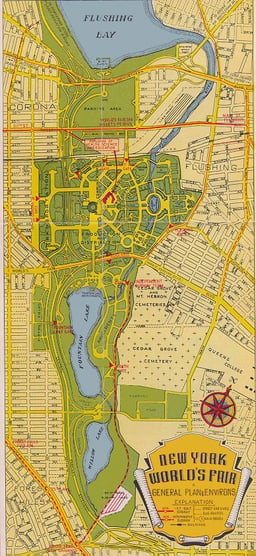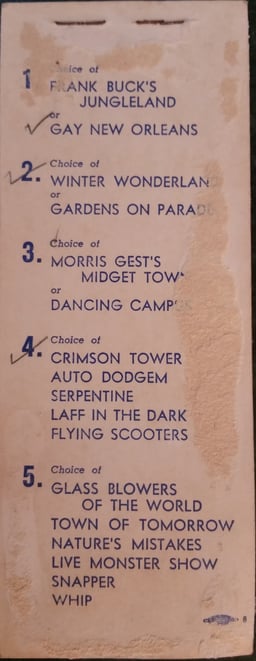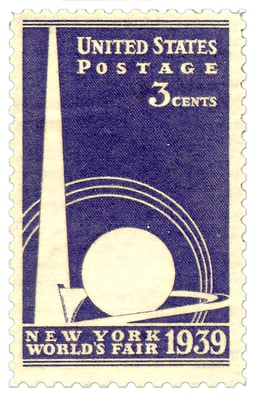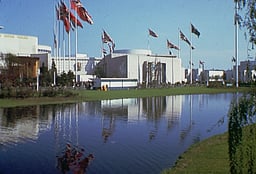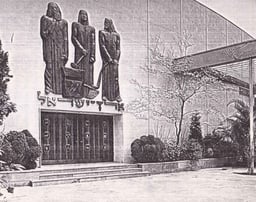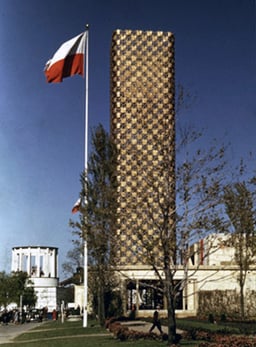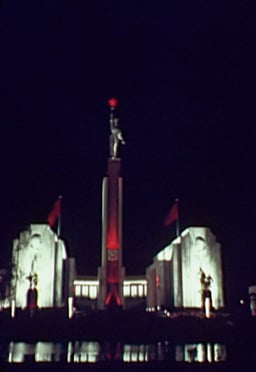1939 New York World's Fair
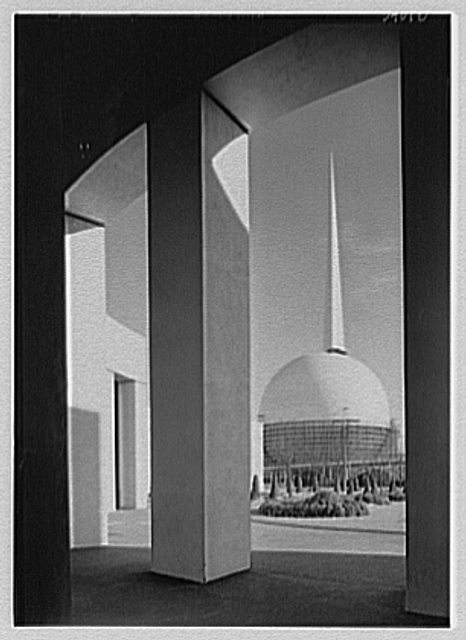
1939 New York World's Fair

| 1939 New York City | |
|---|---|
| Overview | |
| BIE-class | Universal exposition |
| Category | Second category General Exposition |
| Name | New York World's Fair |
| Motto | The World of Tomorrow |
| Area | 1,202 acres (486 hectares) |
| Visitors | 44,932,978 |
| Organized by | Grover Whalen |
| Participant(s) | |
| Countries | 33 |
| Location | |
| Country | United States |
| City | New York City |
| Venue | Flushing Meadows–Corona Park |
| Coordinates | 40°44′38.5″N 73°50′39.9″W [74] |
| Timeline | |
| Opening | April 30, 1939 (1939-04-30)[1] |
| Closure | October 27, 1940 (1940-10-27) |
| Universal expositions | |
| Previous | Exposition Internationale des Arts et Techniques dans la Vie Moderne in Paris |
| Next | Exposition internationale du bicentenaire de Port-au-Prince in Port-au-Prince |
| Specialized Expositions | |
| Previous | Second International Aeronautic Exhibition in Helsinki |
| Next | International Exhibition on Urbanism and Housing (1947) in Paris |
| Simultaneous | |
| Specialized | Exposition internationale de l'eau in Liège |
| Other | Golden Gate International Exposition |
The 1939–40 New York World's Fair, which covered the 1,216 acres (492 ha) of Flushing Meadows–Corona Park (also the location of the 1964–1965 New York World's Fair), was the second most expensive American world's fair of all time, exceeded only by St. Louis's Louisiana Purchase Exposition of 1904. Many countries around the world participated in it, and over 44 million people attended its exhibits in two seasons.[2] It was the first exposition to be based on the future, with an opening slogan of "Dawn of a New Day", and it allowed all visitors to take a look at "the world of tomorrow".
When World War II began six months into the 1939 World's Fair, many exhibits were affected, especially those on display in the pavilions of countries under Axis occupation.
| 1939 New York City | |
|---|---|
| Overview | |
| BIE-class | Universal exposition |
| Category | Second category General Exposition |
| Name | New York World's Fair |
| Motto | The World of Tomorrow |
| Area | 1,202 acres (486 hectares) |
| Visitors | 44,932,978 |
| Organized by | Grover Whalen |
| Participant(s) | |
| Countries | 33 |
| Location | |
| Country | United States |
| City | New York City |
| Venue | Flushing Meadows–Corona Park |
| Coordinates | 40°44′38.5″N 73°50′39.9″W [74] |
| Timeline | |
| Opening | April 30, 1939 (1939-04-30)[1] |
| Closure | October 27, 1940 (1940-10-27) |
| Universal expositions | |
| Previous | Exposition Internationale des Arts et Techniques dans la Vie Moderne in Paris |
| Next | Exposition internationale du bicentenaire de Port-au-Prince in Port-au-Prince |
| Specialized Expositions | |
| Previous | Second International Aeronautic Exhibition in Helsinki |
| Next | International Exhibition on Urbanism and Housing (1947) in Paris |
| Simultaneous | |
| Specialized | Exposition internationale de l'eau in Liège |
| Other | Golden Gate International Exposition |
Planning
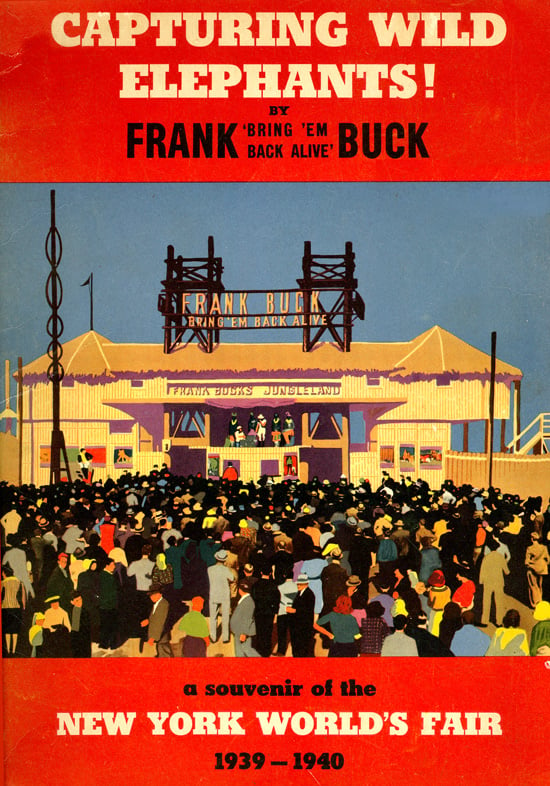
Souvenir booklet
In 1935, at the height of the Great Depression, a group of New York City businessmen decided to create an international exposition to lift the city and the country out of its economic woes. Not long after, these men formed the New York World's Fair Corporation, whose office was placed on one of the higher floors in the Empire State Building. The NYWFC, which elected former chief of police Grover Whalen as president, also included Winthrop Aldrich, Mortimer Buckner, Floyd Carlisle, Ashley T. Cole, John J. Dunnigan, Harvey Dow Gibson, Mayor Fiorello La Guardia, Percy S. Straus, and many other business leaders.
Over the next four years, the committee planned, built, and organized the fair and its exhibits, with countries around the world taking part in creating the biggest international event since World War I. Working closely with the Fair's committee was New York City Parks Commissioner Robert Moses, who saw great value to the City in having the World's Fair Corporation (at its expense) remove a vast ash dump in Queens that was to be the site for the exposition. This event turned the area into a City park after the exposition closed.
Edward Bernays directed public relations of the fair in 1939, which he called "democracity."[3] Grover Whalen, a public relations innovator, saw the Fair as an opportunity for corporations to present consumer products, rather than as an exercise in presenting science and the scientific way of thinking in its own right, as Harold Urey, Albert Einstein, and other scientists wished to see the project.[4] "As events transpired," reported Carl Sagan,[5] whose own interest in science was nevertheless sparked by the Fair's gadgetry, "almost no real science was tacked on to the Fair's exhibits, despite the scientists' protests and their appeals to high principles."
Promotion of the Fair took many forms. During the 1938 Major League Baseball season, the Brooklyn Dodgers, New York Giants, and New York Yankees promoted the event by wearing patches on the left sleeve of their jerseys featuring the Trylon, Perisphere, and "1939." The same year, Howard Hughes flew a special World's Fair flight around the world to promote the fair.
While the main purpose of the fair was to lift the spirits of the United States and drive much-needed business to New York City, it was also felt that there should be a cultural or historical association. It was therefore decided for the opening to correspond to the 150th anniversary of George Washington's first inauguration as President of the United States, and WPA artists painted murals which appeared in the New York Times Magazine.[6]
According to the official pamphlet:
The eyes of the Fair are on the future—not in the sense of peering toward the unknown nor attempting to foretell the events of tomorrow and the shape of things to come, but in the sense of presenting a new and clearer view of today in preparation for tomorrow; a view of the forces and ideas that prevail as well as the machines. To its visitors the Fair will say: "Here are the materials, ideas, and forces at work in our world. These are the tools with which the World of Tomorrow must be made. They are all interesting and much effort has been expended to lay them before you in an interesting way. Familiarity with today is the best preparation for the future.
Grand opening

RCA Exhibit Building
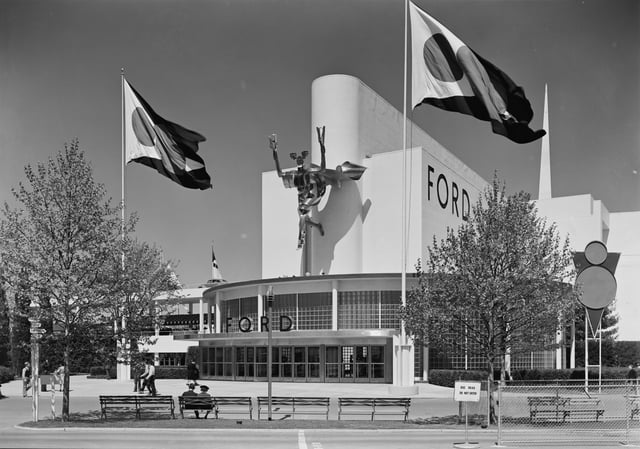
Ford pavilion
On April 30, 1939, a very hot Sunday, the fair had its grand opening, with 206,000 people in attendance. The April 30 date coincided with the 150th anniversary of George Washington's inauguration, in Lower Manhattan, as the first President of the United States. Although many of the pavilions and other facilities were not quite ready for this opening, it was put on with pomp and great celebration.
David Sarnoff, then president of RCA and a strong advocate of television, chose to introduce television to the mass public at the RCA pavilion. As a reflection of the wide range of technological innovation on parade at the fair, Franklin D. Roosevelt's speech was not only broadcast over the various radio networks but also was televised along with other parts of the opening ceremony and other events at the fair. On April 30, 1939, the opening ceremony and President Roosevelt's speech were seen on black and white television sets with 5 to 12-inch tubes.[7] NBC used the event to inaugurate regularly scheduled television broadcasts in New York City over their station W2XBS (now WNBC). An estimated 1,000 people viewed the Roosevelt telecast on about 200 television sets scattered throughout the New York metropolitan area.
In order to convince skeptical visitors that the television sets were not a trick, one set was made with a transparent case so that the internal components could be seen. As part of the exhibit at the RCA pavilion, visitors could see themselves on television. There were also television demonstrations at the General Electric and Westinghouse pavilions. During this formal introduction at the fair, television sets became available for public purchase at various stores in the New York City area.[7]
After Albert Einstein gave a speech that discussed cosmic rays, the fair's lights were ceremonially lit. Dignitaries received a special Opening Day Program which contained their names written in Braille.
Exhibits
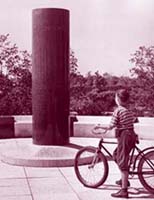
Westinghouse Time Capsule marker
One of the first exhibits to receive attention was the Westinghouse Time Capsule, which was not to be opened for 5,000 years (the year 6939). The time capsule was a tube containing writings by Albert Einstein and Thomas Mann, copies of Life Magazine, a Mickey Mouse watch, a Gillette safety razor, a kewpie doll, a dollar in change, a pack of Camel cigarettes, millions of pages of text on microfilm, and much more. The capsule also contained seeds of foods in common use at the time: (alfalfa, barley, carrots, corn, cotton, flax, oats, rice, soy beans, sugar beets, tobacco & wheat, all sealed in glass tubes). The time capsule is located at 40°44′34.089″N 73°50′43.842″W [75] , at a depth of 50 feet (15 m). A small stone plaque marks the position.[8] Westinghouse also featured "Elektro the Moto-Man": the 7-foot (2.1 m) tall robot that talked, differentiated colors, and even "smoked" cigarettes.[9]
On July 3, 1940, the fair hosted "Superman Day". Notable was the crowning of the "Super-Boy and Super-Girl of the Day" following an athletic contest, and a public appearance by Superman, played by an unidentified man. Broadway actor Ray Middleton, who served as a judge for the contest, is often credited with having appeared in the Superman costume on Superman Day, but he did not; however, he may have played Superman during a live radio broadcast from the scene. Although the unknown man in the costume is often said to have been the first actor ever to play Superman, Bud Collyer had been performing the role on the Superman radio series since the preceding February.
Ralph Vaughan Williams composed his work for harp and string orchestra Five Variants of Dives and Lazarus on commission from the World's Fair. The first performance was at Carnegie Hall in June 1939, conducted by Adrian Boult.[12] In addition, the British Council commissioned a piano concerto from Arthur Bliss for the British Week at the World's Fair. Adrian Boult conducted the New York Philharmonic Symphony Orchestra in Carnegie Hall on June 10, 1939, with Solomon as the soloist.[13]
Ceramic sculptor Waylande Gregory created The Fountain of the Atom, which displayed the largest ceramic sculptures in modern times.[14] It included the four Elements, each measuring 72 inches (180 cm) high and each weighing over a ton. There were also eight electrons, which were illustrated in Life Magazine (March 1939). Gregory also created two exhibitions featuring his ceramic sculptures for the General Motors Building, American Imports and American Exports.
Nylon fabric, the View-Master, and Scentovision (an early version of Smell-O-Vision) were introduced at the Fair. Other exhibits included Vermeer's painting The Milkmaid from the Rijksmuseum in Amsterdam,[15] a streamlined pencil sharpener, a diner (still in operation as the White Mana in Jersey City, New Jersey), a futuristic car-based city by General Motors, and early televisions.[16] There was also a huge globe/planetarium located near the center of the fair. Bell Labs' Voder, a keyboard-operated speech synthesizer, was demonstrated at the Fair.
Themes and zones
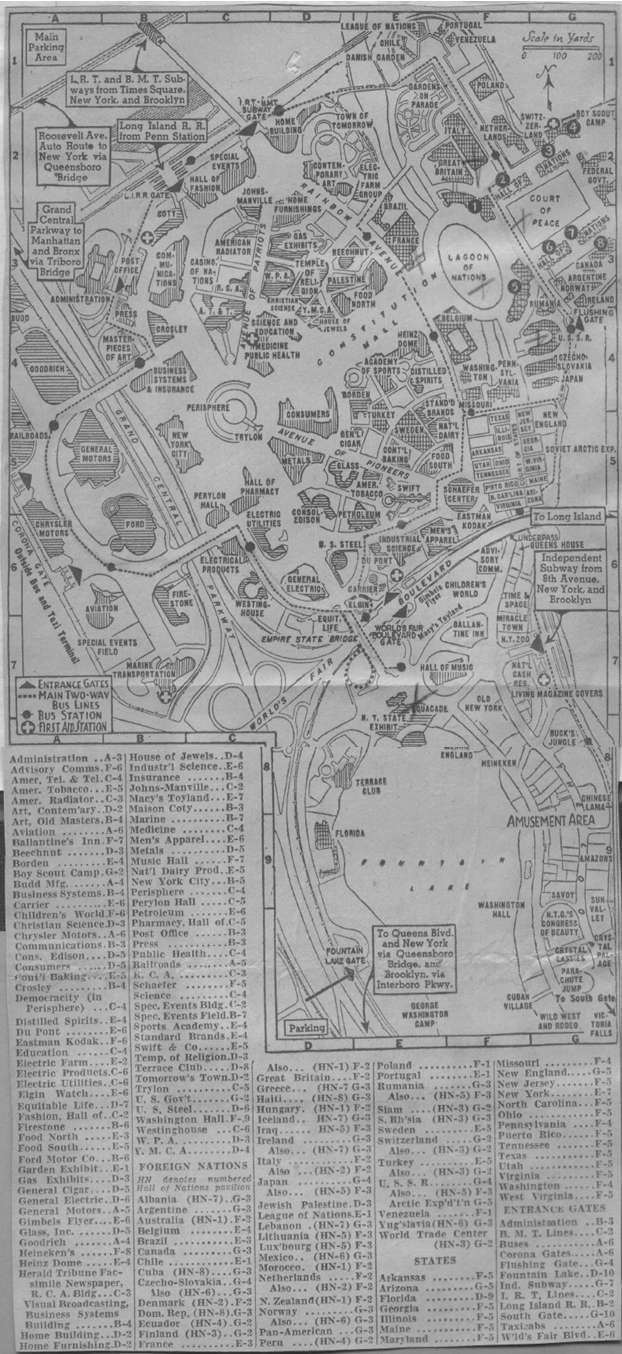
Map showing exhibit locations and transportation access
The fair was divided into differently themed zones, such as the Transportation Zone, the Communications and Business Systems Zone, the Food Zone, the Government Zone, and so forth. Virtually every structure erected on the fairgrounds was extraordinary, and many of them were experimental in many ways. Architects were encouraged by their corporate or government sponsors to be creative, energetic and innovative. Novel building designs, materials and furnishings were the norm. Many of the zones were arranged in a semicircular pattern, centered on the Wallace Harrison and Max Abramovitz-designed Theme Center, which consisted of two all-white, landmark monumental buildings named the Trylon (over 700 feet (210 m) tall) and the Perisphere which one entered by a moving stairway and exited via a grand curved walkway named the "Helicline". Inside the Perisphere was a "model city of tomorrow that visitors" viewed from a moving walkway high above the floor level. The zones were distinguished by many color cues, including different wall colors and tints and differently colored lighting.
The colors blue and orange were chosen as the official colors of the fair, as they were the colors of New York City, and featured prominently. Only the Trylon and Perisphere were all white; avenues stretching out into the zones from the Theme Center were designed with rich colors that changed the further one walked from the center of the grounds. For example, the exhibits and other facilities along the Avenue of Pioneers were in a progression of blues, starting with pale tints and ending in deep ultramarine. At night, with the latest in lighting technology switched on, the effect was felt by many visitors to be a magical experience.
Outdoor public lighting was at the time of a very limited and pedestrian nature, perhaps consisting of simple incandescent pole lamps in a city and nothing in the country. Electrification was still relatively new and had not reached everywhere in the US. The fair was the first public demonstration of several lighting technologies that became common in the following decades. These technologies included the introduction of the first fluorescent light and fixture. General Electric Corporation held the patent to the fluorescent light bulb at the time. Approximately a year later, the original three major corporations, Lightolier, Artcraft Fluorescent Lighting Corporation, and Globe Lighting, located mostly in the New York City region, began wide-scale manufacturing in the US of the fluorescent light fixture.
Another theme of the fair was the emerging new middle class, leading a hoped-for recovery from the Great Depression. The fair promoted the "Middleton Family"—Babs, Bud, and their parents—who appeared in ads showing them taking in the sights of the fair and the new products being manufactured to make life easier and affordable, such as the new automatic dishwasher.
Each day at the fair was a special theme day, for which a special button was issued; for example, May 18, 1939, was "Asbury Park, New Jersey Day". Some of these buttons are very rare and all are considered collectibles.
In 1940, the theme of the fair was changed to "For Peace and Freedom" as war in Europe escalated. One poster from that year's fair, issued by Borden's Milk, had Elsie the Cow proclaiming "makes you proud to be an American".
Transportation Zone

Views of the "World of Tomorrow" (video)
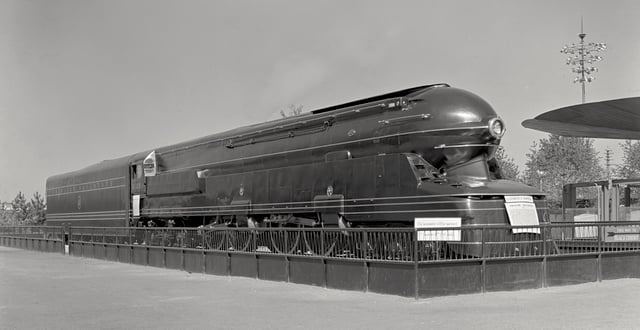
The PRR S1 on display at the fair. This engine ran continuously at 60 mph (97 km/h) on a dynamometer while the fair was open.
With its vast area and prominent location just south of the Theme Center, the Transportation Zone pavilions attracted widespread attention. Perhaps the most popular of the Transportation Zone pavilions was the one built for General Motors. There, the 36,000 square feet (3,300 m2) Futurama exhibit, designed by famed industrial designer and theater set designer Norman Bel Geddes, transported fair visitors over a huge diorama of a fictional section of the United States that was designed with a stunning array of miniature highways, towns, 500,000 individually designed homes, 50,000 miniature vehicles, waterways, and a million miniature trees of diverse species.[17] These elements of the diorama gradually became larger as the visitors, seated in chairs overhead, moved through the exhibit, until the cars and other elements of the exhibit became life-size.
At the conclusion of the ride the visitors to the pavilion exited into an area that was constructed as a life-size city intersection with multistory buildings and stores on all sides. The stores included an auto dealership and an appliance store where visitors could see the latest GM and Frigidaire products. As with almost all pavilions in the fair, these showcases were not only intended to get people to buy the sponsor's products, they were also intended to educate and inform the populace about basic materials and processes that were then very new and not well known. Many experimental product concepts and new materials were shown that were not currently available for purchase, but became available in various ways over the next few years. In many ways the fair pavilions more resembled a modern-day government-sponsored science fair exhibit than they resembled modern corporate advertising and sales promotions.
Adjacent to the GM pavilion was the Ford Pavilion, where race car drivers drove on a figure eight track on the building's roof endlessly, day in and day out. Not far from GM and Ford was the Chrysler exhibit group, where an audience in a theater with air conditioning, then a new technology, could watch a Plymouth being assembled in an early 3D film.
Railroads were a major form of transportation for both passengers and freight in 1939, as airlines are for passengers today. Many visitors to the fair arrived in New York by railroad, and most visitors had at least a moderate interest in the topic. The centerpiece of the Railroad Conference exhibits (on seventeen acres) was "Railroads on Parade", a spectacular live drama re-enacting the birth and growth of railroads. It had music by Kurt Weil and choreography by Bill Matons.[18] In addition to the show, there were important historical objects on display by the various railroads and manufacturing companies, such as the Tom Thumb engine. The Pennsylvania Railroad (PRR) had its S1 engine on display, mounted on rollers under the driver wheels and running continuously at 60 mph (97 km/h) all day long. The British London Midland & Scottish Railway sent their Coronation Scot express train with a locomotive LMS Princess Coronation Class 6229 Duchess of Hamilton, (disguised as sister locomotive 6220 Coronation), to the fair.[19][20] GM's Electro-Motive Division had a display of their then new streamlined diesel-electric passenger locomotives. The Italian state railways displayed one of their record-setting ETR 200 electric multiple unit cars.
Communications and Business Systems Zone
Fairgoers walking to the left of the Theme Center on the Avenue of Patriots visited the Communications and Business Systems focal exhibits. At the AT&T Pavilion the Voder, a mechanized, synthetic voice, spoke to attendees, foretelling the widespread use of electronic voices decades later.
At the IBM pavilion, electric typewriters and a fantastic machine called the "electric calculator" that used punched cards, were on display. IBM also had a fine art gallery with hundreds of artworks from 70 countries around the world.[citation needed] The exhibit for Firestone Tires featured the famous pygmy hippo, Billy, who had been a pet of former US President Calvin Coolidge.
Next door to these business exhibits was the "Masterpieces of Art" building housing 300 priceless works of the Old Masters, from the Middle Ages to 1800. Whalen and his team were able to borrow priceless paintings and sculptures from Europe and hang them in a graceful, understated building in Queens for two years. Thirty five galleries featured great works from DaVinci and Michelangelo to Rembrandt, from Hals to Caravaggio and Bellini.
Government Zone
The 60 foreign governments that participated in the fair contributed a wide diversity of creatively designed pavilions housing a stunning array of cultural offerings to fairgoers. The Italian pavilion attempted to fuse ancient Roman splendor with modern styles, and a 200-foot (61 m) high waterfall defined the pavilion's facade. Its popular restaurant was designed in the shape of the nation's luxury cruise line ships. The French pavilion, on the Court of Peace that was the grand open space northeast of the Theme Center, ran such a celebrated restaurant that after the fair closed and World War II ended, the restaurant remained in New York City. It soon established itself as one of the finest French dining establishments in the city: Le Pavillon.
British Pavilion
The copy of Magna Carta belonging to Lincoln Cathedral also left Britain in 1939 for the first time to be in the British Pavilion at the fair. Within months Britain joined World War II and it was deemed safer for it to remain in America until the end of hostilities. It therefore remained in Fort Knox, next to the original copy of the American constitution, until 1947.
Greek Pavilion
The Greek pavilion was especially interesting because it was a mirror of how the Metaxas quasi-fascist regime wanted to show Greece to the world. The interior rooms were designed by Nelly, the famous Greek photographer. Nelly's collages expressed four aspects of Greece: the legacy of ancient Greece, the Christian spirituality, picturesque landscapes and the Greek racial continuity. On one of its outside walls there were four big murals featuring four historic episodes of Greek history, authored by Gerasimos Steris. After the Fair concluded, the pavilion was dismantled and parts of it were donated for the construction of the Greek Orthodox cathedral of Saint Nicholas in Tarpon Springs, Florida.[21]
Japanese Pavilion
The Japanese pavilion was designed by the Japanese-American architect Yasuo Matsui to resemble a traditional Shinto shrine, set within a Japanese garden. It offered tea ceremony and Japanese flower arrangement exhibits. The interior had a "Diplomat room", which featured a reproduction of the Liberty Bell made out of Japanese pearls and diamonds, worth $1 million. This room also featured a photomontage mural across which was written the motto "Dedicated to Eternal Peace and Friendship between America and Japan". Japan and the US went to war on 8 December 1941, a year after the exhibition closed.[22]
The interior of the pavilion was designed by the Japanese architect and photographer Iwao Yamawaki, who studied at the Bauhaus school in Germany in the early 1930s.[23]
Jewish Palestine Pavilion
The Jewish Palestine Pavilion introduced the world to the concept of a modern Jewish state, which a decade later became Israel. The pavilion featured a monumental hammered copper relief sculpture on its façade titled The Scholar, The Laborer, and the Toiler of the Soil by the noted Art Deco sculptor Maurice Ascalon.
Polish Pavilion
The Second Polish Republic prepared some 200 tons of various works of art. In mid-February 1939, all items were transported by train to the port of Gdynia, where they were loaded on MS Batory, which left Gdynia on February 28. Among most important items presented by Poland in New York City were: a royal carpet of King Kazimierz Jagiellończyk, seven paintings presenting important events of Polish history, 150 contemporary Polish paintings, a gunmetal monument of Józef Piłsudski, armor of a Polish hussar from Kórnik Castle, ancient Polish weaponry (14th–18th centuries), a bell manufactured for the purpose of the Fair, folk costumes, house furniture from different regions of Poland, and examples of Polish inventions.
USSR Pavilion
Exhibitions in the USSR (Soviet) Pavilion included the life-size copy of the interior of the showcase Mayakovskaya station of the Moscow Metro. Designer of the station Alexey Dushkin was awarded Grand Prize of the 1939 New York World's Fair.[24] The USSR Pavilion was originally 260 feet (79 m) tall, including a statue atop its roof.[25][26] The pavilion was only open for 1939 and was razed at the end of that year.[27]
Food Zone
Continuing outward from the Theme Center, one saw the Food Zone. Among the many unique exhibits was the Borden's exhibit, that featured 150 pedigreed cows (including the original Elsie) on a Rotolactor that allowed bathing them, drying them, and milking them in a highly mechanized way. While no such complete system ever became common in milk production, many of its features came into everyday use in today's rotary milking parlors.
Next door was the Continental Baking exhibit, presenting a vast, continuous process of baking breads and other products. Consistent with the representative design sense of the Fair, this building was fashioned in the shape of a huge packaged bread loaf, white with red, yellow, and blue balloons on its curved facade. Americans today will recognize this as the packaging for Wonder Bread. Behind the exhibit was a field from which wheat was harvested and used in the baking process. There was a sign in the field that noted that this was the first time in over 100 years that wheat had been grown within the incorporated bounds of New York City.
Amusement Area
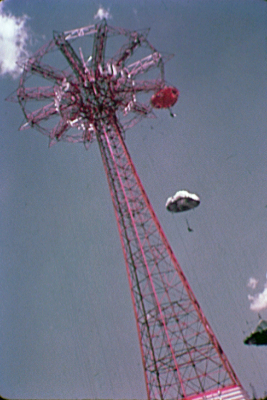
Life Savers Parachute Jump
Beyond the corporate and government zones, the wildly popular but less uplifting Amusements Area was not integrated into the thematic matrix, and was a mere Area rather than a Zone. Despite the high-minded educational tone that Grover Whalen attempted to set, the Amusements Area was the most popular part of the Fair, and included a roller coaster, the Life Savers Parachute Jump[28] (later moved to Coney Island, where it still stands today[29]), the 3 ft (914 mm) narrow gauge Gimbels Flyer train ride (later purchased by Kennywood, where it still runs today),[30] and carnival acts such as a collection of performing dwarves.
Frank Buck exhibited his "Frank Buck's Jungleland", which displayed rare birds, reptiles and wild animals along with Jiggs, a five-year-old trained orangutan. In addition, Buck provided a trio of performing elephants, an 80-foot (24 m) "monkey mountain" with 600 monkeys, and an attraction that had been popular at the 1893 Chicago World's Fair: camel rides.[31] A number of the shows provided spectators with the opportunity of viewing women in very revealing costumes or topless, such as the "Frozen Alive Girl", the Living Pictures, and the Dream of Venus building. This last attraction was a pavilion designed by the Spanish surrealist artist Salvador Dalí which contained within it a number of unusual sculptures and statues as well as live nearly-nude performers posing as statues.[32][33] While there were a number of protests by prominent politicians over the course of the fair about the "low minded entertainment," and the New York Vice Squad raided shows in the area on several occasions, the public generally accepted this form of entertainment.
Bendix Lama Temple girlie show
The Bendix Lama Temple[34] was a 28,000-piece full-sized replica of the 1767 Potala temple in Jehol, Manchuria, commissioned and brought back by the industrialist and explorer Vincent Bendix.[35][36][37] The Temple had previously been exhibited at the 1933 Chicago World's Fair, called "Century of Progress".[38] In New York, the Temple contained a girlie show.
Aquacade
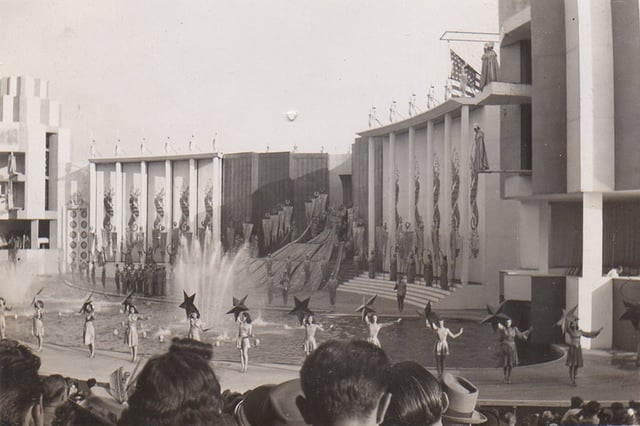
Audience members viewing The Billy Rose Aquacade at the 1939–40 Worlds Fair.
Billy Rose's Aquacade was a spectacular musical and water extravaganza foreshadowing the form of many popular Hollywood musicals in the ensuing years. The show was presented in a special amphitheater seating 10,000 people and included an orchestra to accompany the spectacular synchronised swimming performance. It featured Johnny Weissmuller and Eleanor Holm, two of the most celebrated swimmers of the era, and dazzled fairgoers with its lighting and cascades and curtains of water, pumped in waterfalls at 8,000 gallons a minute. The cost of admission was 80 cents.
The Aquacade facility itself served as an entertainment venue in the park for many years afterward, including the 1964–65 World's Fair, but fell into disrepair in the 1980s and was finally demolished in 1996.
Good Neighbor Policy

Pamphlet promoting tourism in Argentina during the 1939 World's Fair
The New York World's Fair of 1939 was just the place to promote neighborly relations between the US and Latin America. Placed against the backdrop of a growing Nazi threat, the World's Fair was an attempt to escape from the looming prospect of war and to promote peace and interdependence between nations. With the fair boasting over 60 countries, with some coming from Latin America, this was the place to redefine negative Latin American stereotypes.[39] Argentina, Brazil, Chile, Venezuela, Cuba, Mexico, Nicaragua and the Pan American Union were all represented at the World's Fair. Each country seized the opportunity to showcase their country and to make it more appealing to those around the world, especially in the United States. In their bid to increase cultural awareness at the World's Fair, the countries promoted tourism and strived to compare itself to the United States in an effort to appeal to Americans.[40]
Transportation
A special subway line, the IND World's Fair Line, was built to serve the fair. World's Fair (now Mets – Willets Point) station on the IRT Flushing Line was rebuilt to handle fair traffic on the IRT and BMT. A Long Island Rail Road station (now Mets – Willets Point) was built next to the Flushing Line station. The IND extension departed the IND Queens Boulevard Line east of the Forest Hills – 71st Avenue station and before the 75th Avenue station. The World's Fair station was at the east side of the Meadowlands at Horace Harding Boulevard. The period system route map and Fair maps display this temporary extension.[41] The World's Fair station was a terminus of the G train (alternate E trains also ran to World's Fair Station), and ran at ground level, separated from the Fair grounds by a fence, past the Jamaica Yard, which is still in use.[42]
For the 1939–40 Fair, a special fleet of 50 "World's Fair Steinway" cars were delivered in late 1938 by the St. Louis Car Company for Flushing Line service. Car #5655 survives in the New York Transit Museum fleet.
Closure and current status
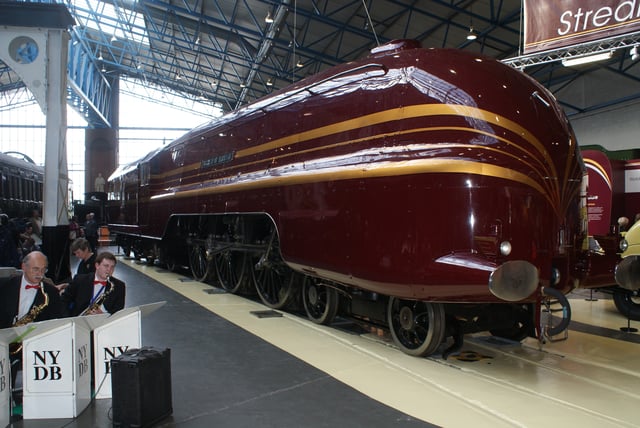
World's Fair exhibit Duchess of Hamilton, now preserved in York, England
The fair was open for two seasons, from April to October each year, and was officially closed permanently on October 27, 1940.[43] To get the fair's budget overruns under control before the 1940 season and to augment gate revenues, Whalen was replaced by banker Harvey Gibson. In addition, much greater emphasis was placed on the amusement features and less on the educational and uplifting exhibits. The great fair attracted over 45 million visitors and generated roughly $48 million in revenue. Since the Fair Corporation had invested 67 million dollars (in addition to nearly a hundred million dollars from other sources), it was a financial failure, and the corporation declared bankruptcy.
Many of the rides from the World's Fair were sold after its closure to Luna Park, Coney Island which was allowed to call itself the New York World's Fair of 1941.[44] The Life Savers Parachute Jump was sold that same year to become the Parachute Jump at Steeplechase Park.
The Unisphere, built as the theme symbol for the 1964/1965 World's Fair, now stands on the site occupied by the Perisphere during the earlier Fair.
World War II
Although the United States did not enter World War II until the end of 1941, the fairgrounds served as a window into the troubles overseas. The pavilions of Poland and Czechoslovakia, for example, did not reopen for the 1940 season. Also on July 4 that same year, two New York City Police Department officers were killed by a blast while investigating a time bomb left at the British Pavilion.[45] The bombing has never been solved, but there is evidence that bombing was an inside job by William Stephenson, a British agent based in New York.[46]
Countries under the thumb of the Axis powers in Europe in 1940 like Poland, Czechoslovakia, and France ran their pavilions with a special nationalistic pride. The only major world power that did not participate for the 1939 season was Germany, citing budget pressures. The USSR Pavilion was dismantled after the first season, leaving an empty lot called "The American Commons". When the fair closed, many among the European staff were unable to return to their home countries, so they remained in the US and in some cases exercised a tremendous influence on American culture. For example, Henri Soulé moved from the French Pavilion at the fair to open Le Pavillon restaurant, retaining Pierre Franey as head chef.[47][48]
World War II presented additional problems with what to do with the exhibits on display in the pavilions of countries under Axis occupation. In the case of the Polish Pavilion, most of the items were sold by the Polish Government in exile in London to the Polish Museum of America and shipped to Chicago. A notable exception was made for a monument of the Polish–Lithuanian King Jagiełło to which Mayor Fiorello La Guardia took such a liking that he helped spearhead a campaign to have it installed in Central Park, where it still stands today.[49]
Belgian Pavilion
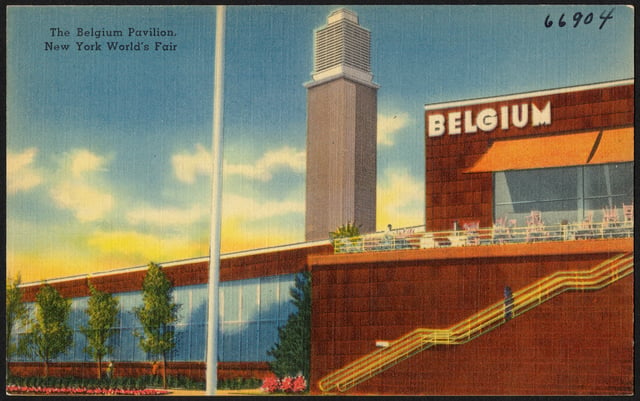
Belgium Pavilion
Another building saved from 1940 was the Belgian Building designed by Henry Van de Velde. It was awarded to Virginia Union University in Richmond, Virginia, and shipped to Richmond in 1941. The school still uses the building for its home basketball games.[50]
Bendix Lama Temple
After the Fair, the Temple was again disassembled, and placed in storage for many years. There were proposals to erect it at Oberlin College, Harvard University, Indiana University, and elsewhere, but they all failed for lack of funding. In 1984, the approximately 28,000 pieces were shipped to the Museum of Ethnography in Stockholm, Sweden, with plans to rebuild it in a nearby park, but objections from the neighboring Chinese Embassy have stalled the project indefinitely.[36][37][51]
New York City Building
Some of the buildings from the 1939 fair were used for the first temporary headquarters of the United Nations from 1946 until it moved in 1951 to its permanent headquarters in Manhattan. The former New York City Building was used for the UN General Assembly during that time.[52] This building was later refurbished for the 1964 fair as the New York City Pavilion, featuring the Panorama of the City of New York, an enormous scale model of the entire city.[53] It became the home of the Queens Center for Art and Culture (later renamed the Queens Museum of Art, and now called the Queens Museum), which still houses and occasionally updates the Panorama.
One other structure from the 1939-40 Fair remains in original location: the New York City Subway's Mets–Willets Point station, rebuilt for the Fair. It also served the 1964-65 events and continues to serve New York Mets games and US Open Tennis.
Cultural references
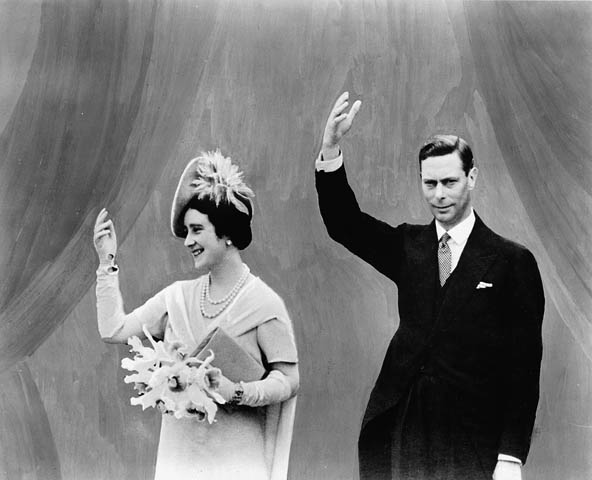
King George VI and Queen Elizabeth of the United Kingdom, during a visit to the Canadian Pavilion
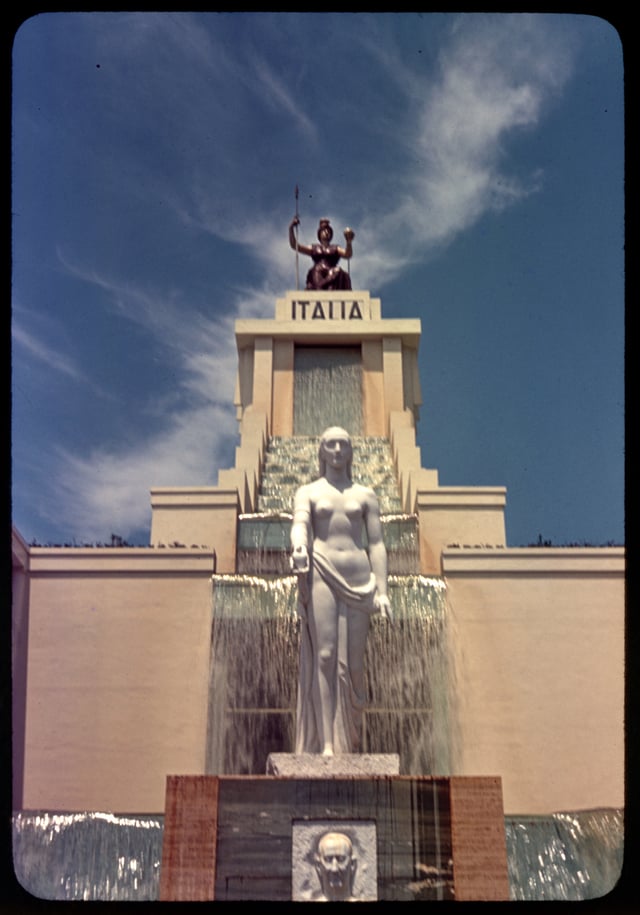
Italian Pavilion
The 1939 World's Fair made a strong impression on attendees and influenced a generation of Americans. Later generations have attempted to recapture the impression it made in fictional and artistic treatments.
Film and television
The still under-construction fair appeared in the finale of The Giggling Ghosts (1938).
Finale of the 1939 film Eternally Yours takes place in the fair
In Walt Disney's Pinocchio (1940), the pool hall on Pleasure Island is shaped as an eight ball, with a cue next to it, a clever parody of the Trylon and Perisphere of the 1939 World's Fair.
In the film Mr. & Mrs. Smith (1941), a comedy directed by Alfred Hitchcock, Carole Lombard and Gene Raymond visit the fair after a dinner date and find themselves stuck high in the air on the fair's popular parachute ride when it malfunctions.
The Pinky and the Brain episode "Mice Don't Dance" (3-11a) takes place in the 1939 World's Fair.
The Twilight Zone Season 2 episode "The Odyssey of Flight 33" follows Flight 33 lost in time and briefly in 1939, with a sky view of the World's Fair. However, the pilot incorrectly identifies the location as Lake Success, which actually is in Nassau County, not Queens County.
In The Simpsons 2003 episode "Brake My Wife, Please", Mr. Burns gives Homer a ticket to the fair as a reward for being the first employee to arrive at work that day. The ticket shown features the Trylon and Perisphere, as well as the opening and closing dates of the fair.
In the 2011 film Captain America: The First Avenger, a very similar "World Exposition of Tomorrow" is featured at the same Flushing Meadows location, albeit in 1943, a year when no World Fair was held anywhere due to World War II.
In the 1992 film Forever Young, Nat (Elijah Wood) explains to Daniel (Mel Gibson) that what he is watching is called "television". Daniel replies to a disbelieving Nat, "I know, I saw it at the World's Fair in 1939."
Literature
E.B. White recounts a visit to the fair in his 1939 essay "The World of Tomorrow".[54]
The still under-construction fair was the focus of the entire book The World's Fair Goblin (1939), which was written in the fall of 1938 after the editors and authors were given a private fact-finding/research tour of the fair. The original draft of The World's Fair Goblin was called The Man of Tomorrow, but it was considered better advertising to include the World's Fair name in the title.
DC Comics published a 1939 New York World's Fair Comics comic book, followed by a 1940 edition in the next year. It became the precursor of the long-running Superman/Batman team-up book World's Finest Comics. The 1939 and 1940 comics were sometimes referenced in All-Star Squadron. Early Superman was described as a result of natural evolution from the inhabitants of his native world, leading to his alias "Man of Tomorrow", which reminds one of the "World of Tomorrow" theme of the Fair.
Doc Savage, a popular fictional character of the Pulp Era who used scientific detection in his adventures, was seen as a perfect match for the fair's "world of the future" concept. President Grover Whalen to do a Grand Opening cross promotion with the publisher, Street & Smith.
In the novel The Amazing Adventures of Kavalier & Clay (2000) by Michael Chabon, one of the main characters breaks into the abandoned fairgrounds and the Perisphere.
The fair is featured prominently in the graphic novel Whatever Happened to the World of Tomorrow? by Brian Fies. In it, a father takes his young son to the fair which inspires him to a lifelong fascination with the promise of a hopeful, wonder-filled future.
Australian novelist and scriptwriter Frank Moorhouse places several chapters of his award-winning novel Dark Palace at the World's Fair. The novel's protagonist, Edith Campbell Berry, works for the League of Nations and in one episode she is presented as the driving force behind the flying of the League's flag alongside those of the United States and the State of New York.
E.L. Doctorow's semi-autobiographic novel The World's Fair (1985) culminates with a lengthy description of a young boy's visit to the Fair.
DC Comics' All-Star Squadron (1981-1987) started using the Perisphere and Trylon as the Squadron's base of operations starting in All-Star Squadron #21.
Other
"Fifty Years After the Fair", a song written and recorded by Aimee Mann, describes the Fair from the current vantage point of "tomorrow", with a mixture of nostalgia and remorse.
Three well-respected French restaurants—La Caravelle, Le Pavillon, and La Côte Basque—were offshoots "of the seminal restaurant in the French pavilion of the 1939 New York World's Fair, where Charles Masson père began as a waiter under the eye of the legendary Henri Soulé".[55]
Archives
An archive of documents and films from the 1939 New York World's Fair is maintained at the New York Public Library (NYPL). This collection of official corporate records from the fair is one of the richest and most heavily used collections at NYPL.[56] Extensive highlights from the collection can be viewed online,[56] or via an award-winning free iPad app.[57]
In October 2010, the National Building Museum in Washington, D.C. opened an exhibition titled Designing Tomorrow: America's World's Fairs of the 1930s.[58] This exhibition, which was available for view until September 2011, prominently featured the 1939 New York World's Fair.
See also
Exhibition of the Industry of All Nations - earlier World's Fair in New York City
1964 New York World's Fair – later World's Fair on the same site
Flushing Meadows–Corona Park – current park area on which the World's Fairs were held
List of world expositions
List of world's fairs


